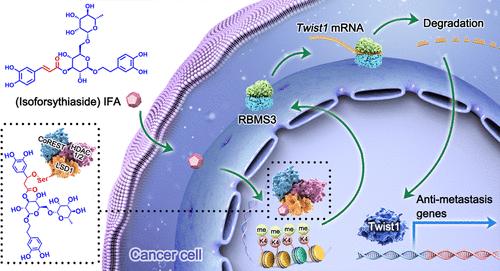Target Ligand Separation and Identification of Isoforsythiaside as a Histone Lysine-Specific Demethylase 1 Covalent Inhibitor Against Breast Cancer Metastasis
IF 5.3
2区 材料科学
Q2 MATERIALS SCIENCE, MULTIDISCIPLINARY
引用次数: 0
Abstract
Histone lysine-specific demethylase 1 (LSD1) is hyperactive in breast cancer, which is associated with the metastasis of the tumor. Current irreversible LSD1 inhibitors are all synthesized by covalently binding to the flavin adenine dinucleotide cofactor, which often have side effects due to the high affinity for a variety of targets. Here, we identified isoforsythiaside (IFA), a natural phenylpropanoid glycoside isolated from Forsythia suspensa, as a novel covalent inhibitor of LSD1. The target ligand fishing technique and LC–MS/MS analysis identified that IFA could covalently bind to the Ser817 residue of LSD1 by α,β-unsaturated ketone moiety to block the amine oxidase-like domain of LSD1. Moreover, RBMS3/Twist1/MMP2, the downstream signaling pathway of LSD1, was activated after IFA treatment to inhibit the metastasis of MDA-MB-231 cells in vitro and in vivo. This study provided novel molecular templates for development of LSD1 covalence-binding inhibitor and laid a foundation for developing agents against breast carcinoma metastasis for targeting LSD1.

目标配体分离与异佛手苷作为组蛋白赖氨酸特异性去甲基化酶 1 共价抑制剂抗乳腺癌转移的鉴定
组蛋白赖氨酸特异性去甲基化酶1(LSD1)在乳腺癌中活性亢进,这与肿瘤的转移有关。目前不可逆的 LSD1 抑制剂都是通过与黄素腺嘌呤二核苷酸辅因子共价结合合成的,由于对多种靶点具有高亲和力,往往会产生副作用。在这里,我们发现了一种从连翘中分离出来的天然苯丙苷(isoforsythiaside,IFA),它是一种新型的 LSD1 共价抑制剂。通过靶配体捕获技术和LC-MS/MS分析发现,IFA可通过α,β-不饱和酮分子与LSD1的Ser817残基共价结合,从而阻断LSD1的胺氧化酶样结构域。此外,IFA处理后,LSD1的下游信号通路RBMS3/Twist1/MMP2被激活,从而抑制了MDA-MB-231细胞在体外和体内的转移。这项研究为开发LSD1共价结合抑制剂提供了新的分子模板,为开发针对LSD1的抗乳腺癌转移药物奠定了基础。
本文章由计算机程序翻译,如有差异,请以英文原文为准。
求助全文
约1分钟内获得全文
求助全文
来源期刊

ACS Applied Nano Materials
Multiple-
CiteScore
8.30
自引率
3.40%
发文量
1601
期刊介绍:
ACS Applied Nano Materials is an interdisciplinary journal publishing original research covering all aspects of engineering, chemistry, physics and biology relevant to applications of nanomaterials. The journal is devoted to reports of new and original experimental and theoretical research of an applied nature that integrate knowledge in the areas of materials, engineering, physics, bioscience, and chemistry into important applications of nanomaterials.
 求助内容:
求助内容: 应助结果提醒方式:
应助结果提醒方式:


